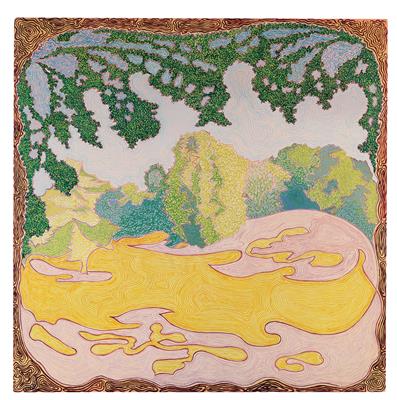Giacomo Balla *

(Turin 1871–1958 Rome)
Paesaggio estivo (Villa Borghese), 1926, signed FUTURBALLA, signed and titled on the reverse Balla Pittore “Paesaggio estivo” VILLA BORGHESE, oil on wood panel, 125 x 125 cm, framed
Photo certificate:
Luce Balla, daughter of the artist
Archivio Elena Gigli, Rome, no. 2019/884
Provenance:
Atelier Balla, Rome (listed in the family notebook under the number 228, original handwritten label on the reverse)
Acquired from the daughters of the artist in 1971
by the present owner and thence by inheritance
Private Collection, Italy
Literature:
T. Fiori/M. Drudi Gambillo, Archivi del Futurismo, De Luca ed., Rome, 1962, vol. II, p. 172, no. 358 with ill at p. 79
Elica Balla, Con Balla, Multipla Edizioni, Rome 1986, p. 79 with ill.
Around the middle of the nineteenth century, following Japan’s commercial opening to the rest of the world, a certain passion for Japanese aesthetics and culture began to develop in the United States and Europe.
Just as in the eighteenth century the world had been fascinated by “chinoiserie” from China, so from the end of the nineteenth century to the first decades of the twentieth it was Japan that exerted a considerable influence on Western art and culture.
The skilled French engraver Philippe Burty coined the term “Japonisme” to describe this new trend, and in 1878 the World’s Fair of Paris officially marked its inception by presenting many works by Japanese artists.
It became particularly fashionable to collect “ukiyo-e” prints, which were interestingly already known to Europeans thanks to the East India Company. These precious graphic works had been used for decades as “packaging” for porcelain products from Japan. Often they were woodcuts of important Japanese artists such as Utamaro, Hokusai, Hiroshige, Kunisada - masters of their time and well known today.
The style of Japanese prints is characterised by two-dimensionality and an almost “photographic” style where the subject is often observed from unusual points of view that neglect the rules of perspective - a new and original vision for Western artists. Graphically, movement is rendered through soft, sinuous lines that, in the absence of chiaroscuro, define fields of pure colour.
From the Paris exhibition onwards, “Japonisme” stylistically influenced the whole of Europe. The Impressionists and post-Impressionists (especially Vincent van Gogh) also became passionate collectors of Japanese art and prints.
The founder of the Vienna Secession, Gustav Klimt (whose stylisations are clearly inspired by the ornamental character of Japanese prints) and his colleagues put on an exhibition of art from the Far East, while in the workshops of the Wiener Werkstätte the Japanese technique of stencil printing, based on negative-positive effects, was successfully recreated.
At the beginning of the twentieth century, the advent of Art Nouveau and Modernist culture throughout Europe, only served to emphasise the “Japonist” trend by rejecting the styles of the past and seeking inspiration in the decorative elegance of nature.
Even the young Giacomo Balla, in Paris in the early years of the twentieth century, was not insensitive to the charm of this new style of representation. Its subjects, often inspired by nature, were particularly close to the thought of this revolutionary artist who used to to declare: “The complete painter loves the eternal truth in the expression of NATURE”.
Expert: Maria Cristina Corsini
 Maria Cristina Corsini
Maria Cristina Corsini
+39-06-699 23 671
maria.corsini@dorotheum.it
26.11.2019 - 17:00
- Dosažená cena: **
-
EUR 302.200,-
- Odhadní cena:
-
EUR 180.000,- do EUR 220.000,-
Giacomo Balla *
(Turin 1871–1958 Rome)
Paesaggio estivo (Villa Borghese), 1926, signed FUTURBALLA, signed and titled on the reverse Balla Pittore “Paesaggio estivo” VILLA BORGHESE, oil on wood panel, 125 x 125 cm, framed
Photo certificate:
Luce Balla, daughter of the artist
Archivio Elena Gigli, Rome, no. 2019/884
Provenance:
Atelier Balla, Rome (listed in the family notebook under the number 228, original handwritten label on the reverse)
Acquired from the daughters of the artist in 1971
by the present owner and thence by inheritance
Private Collection, Italy
Literature:
T. Fiori/M. Drudi Gambillo, Archivi del Futurismo, De Luca ed., Rome, 1962, vol. II, p. 172, no. 358 with ill at p. 79
Elica Balla, Con Balla, Multipla Edizioni, Rome 1986, p. 79 with ill.
Around the middle of the nineteenth century, following Japan’s commercial opening to the rest of the world, a certain passion for Japanese aesthetics and culture began to develop in the United States and Europe.
Just as in the eighteenth century the world had been fascinated by “chinoiserie” from China, so from the end of the nineteenth century to the first decades of the twentieth it was Japan that exerted a considerable influence on Western art and culture.
The skilled French engraver Philippe Burty coined the term “Japonisme” to describe this new trend, and in 1878 the World’s Fair of Paris officially marked its inception by presenting many works by Japanese artists.
It became particularly fashionable to collect “ukiyo-e” prints, which were interestingly already known to Europeans thanks to the East India Company. These precious graphic works had been used for decades as “packaging” for porcelain products from Japan. Often they were woodcuts of important Japanese artists such as Utamaro, Hokusai, Hiroshige, Kunisada - masters of their time and well known today.
The style of Japanese prints is characterised by two-dimensionality and an almost “photographic” style where the subject is often observed from unusual points of view that neglect the rules of perspective - a new and original vision for Western artists. Graphically, movement is rendered through soft, sinuous lines that, in the absence of chiaroscuro, define fields of pure colour.
From the Paris exhibition onwards, “Japonisme” stylistically influenced the whole of Europe. The Impressionists and post-Impressionists (especially Vincent van Gogh) also became passionate collectors of Japanese art and prints.
The founder of the Vienna Secession, Gustav Klimt (whose stylisations are clearly inspired by the ornamental character of Japanese prints) and his colleagues put on an exhibition of art from the Far East, while in the workshops of the Wiener Werkstätte the Japanese technique of stencil printing, based on negative-positive effects, was successfully recreated.
At the beginning of the twentieth century, the advent of Art Nouveau and Modernist culture throughout Europe, only served to emphasise the “Japonist” trend by rejecting the styles of the past and seeking inspiration in the decorative elegance of nature.
Even the young Giacomo Balla, in Paris in the early years of the twentieth century, was not insensitive to the charm of this new style of representation. Its subjects, often inspired by nature, were particularly close to the thought of this revolutionary artist who used to to declare: “The complete painter loves the eternal truth in the expression of NATURE”.
Expert: Maria Cristina Corsini
 Maria Cristina Corsini
Maria Cristina Corsini
+39-06-699 23 671
maria.corsini@dorotheum.it
|
Horká linka kupujících
Po-Pá: 10.00 - 17.00
kundendienst@dorotheum.at +43 1 515 60 200 |
| Aukce: | Moderní |
| Typ aukce: | Salónní aukce |
| Datum: | 26.11.2019 - 17:00 |
| Místo konání aukce: | Wien | Palais Dorotheum |
| Prohlídka: | 16.11. - 26.11.2019 |
** Kupní cena vč. poplatku kupujícího a DPH
Není již možné podávat příkazy ke koupi přes internet. Aukce se právě připravuje resp. byla již uskutečněna.
Všechny objekty umělce
